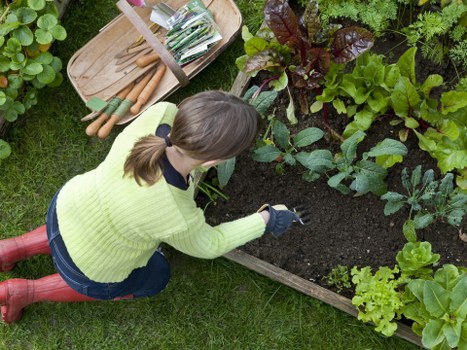Comprehensive Guide to Hedge Trimming in Sutton
Introduction to Hedge Trimming

Maintaining a well-manicured garden greatly enhances the aesthetic appeal of any property. One of the key elements in garden maintenance is hedge trimming. In Sutton, where gardens are cherished as extensions of living spaces, proper hedge trimming ensures that hedges remain healthy, attractive, and well-shaped.
Hedges serve multiple functions, from privacy screens and windbreaks to decorative elements that define garden boundaries. Regular trimming not only preserves their shape but also promotes vigorous growth, preventing overgrowth and potential damage to nearby structures.
Understanding the best practices for hedge trimming in Sutton's specific climate and soil conditions can significantly impact the health and appearance of your hedges. This article delves into the techniques, tools, and tips necessary for effective hedge maintenance.
Why Regular Hedge Trimming Matters

Regular trimming is essential for several reasons. Firstly, it encourages dense and robust growth, ensuring that the hedge remains thick and full. Without periodic trimming, hedges can become sparse and unruly, detracting from the overall garden's appearance.
Secondly, timely hedge trimming helps prevent diseases and pests. Overgrown hedges can harbor insects and create environments conducive to fungal infections. By trimming regularly, you reduce these risks and maintain the plants' health.
Additionally, well-trimmed hedges can enhance property value. A lush, neatly maintained hedge adds to the curb appeal, making your home more attractive to potential buyers.
Best Time to Trim Hedges in Sutton

Timing is crucial when it comes to hedge trimming. In Sutton, the optimal periods are typically during late spring and early autumn. Trimming during these times allows the hedges to recover and continue healthy growth before the harsher weather conditions of winter or the intense heat of summer.
Avoid trimming in late summer or during the flowering period, as this can stress the plants and reduce their ornamental value. Understanding the specific growth cycles of your hedge species will guide you in scheduling trims that support their natural growth patterns.
Moreover, regular observation of your hedges will help determine the best times for maintenance, ensuring that they remain in top condition throughout the year.
Essential Tools for Hedge Trimming

Having the right tools is fundamental to achieving precise and clean trims. Essential tools for hedge trimming in Sutton include:
- Hedge trimmers: Available as manual, electric, or gas-powered, these are crucial for making straight and uniform cuts.
- Pruning shears: Best for detailed work and trimming smaller branches.
- Loppers: Useful for cutting thicker branches that are beyond the capacity of pruning shears.
- Gloves and protective gear: To ensure safety while handling sharp tools and dense foliage.
- Ladders: Necessary for reaching higher sections of tall hedges accurately.
Investing in high-quality tools not only makes the trimming process more efficient but also contributes to the longevity and health of your hedges.
Step-by-Step Guide to Trimming Your Hedge

Trimming your hedge in Sutton can be a straightforward process if approached methodically. Follow these steps to achieve professional-looking results:
- Assess the Hedge: Examine the overall shape, health, and growth pattern of your hedge. Identify any diseased or damaged branches that need removal.
- Choose the Right Tools: Select appropriate tools based on the hedge's thickness and height.
- Trim the Top: Start by trimming the top of the hedge to your desired height, ensuring an even line.
- Shape the Sides: Trim the sides to create a uniform shape, typically slightly narrower at the top to allow sunlight penetration.
- Clean Up: Remove any loose branches and debris to prevent pests and diseases.
Regular maintenance following these steps will keep your hedges looking sharp and healthy throughout the seasons.
Common Mistakes to Avoid
Even with the best intentions, several common mistakes can compromise the health and appearance of your hedges:
- Over-trimming: Cutting back too much can stress the plants, leading to stunted growth and vulnerability to diseases.
- Trimming at the Wrong Time: Pruning during the blooming period or extreme weather conditions can negatively impact the hedge's health.
- Using Dull Tools: Dull blades cause ragged cuts, making the plants more susceptible to infections.
- Ignoring Plant Health: Failing to address diseased or damaged branches can spread problems throughout the hedge.
Avoiding these mistakes ensures that your hedge remains robust and visually appealing.
Choosing the Right Hedge Plants for Sutton Climate
Sutton's climate plays a significant role in determining the best types of hedges to plant and maintain. Selecting species that thrive in the local conditions will reduce maintenance efforts and enhance garden beauty.
- Boxwood: A popular choice due to its dense foliage and ability to maintain precise shapes.
- Privet: Fast-growing and adaptable, making it ideal for privacy screens.
- Laurel: Offers glossy leaves and robust growth, perfect for year-round greenery.
- Holly: Provides both aesthetic appeal with its berries and practical benefits as a protective barrier.
- Yew: Long-lived and versatile, suitable for both formal and informal garden styles.
Consulting with local nurseries can provide insights into the best hedge species suited for Sutton's environment.
Eco-Friendly Trimming Practices
Adopting eco-friendly trimming practices contributes to a sustainable garden. Here are some tips to ensure your hedge trimming is environmentally responsible:
- Use Sustainable Tools: Opt for electric or manual trimmers over gas-powered ones to reduce carbon emissions.
- Recycle Green Waste: Compost the trimmed branches instead of sending them to landfill.
- Minimize Chemical Use: Limit the use of pesticides and fertilizers, choosing organic alternatives when necessary.
- Promote Biodiversity: Incorporate a variety of hedge species to support local wildlife and beneficial insects.
These practices not only benefit the environment but also promote healthier and more resilient hedges.
Hiring Professional Hedge Trimmers in Sutton
While DIY trimming is feasible, hiring professional hedge trimming services in Sutton can offer numerous advantages:
- Expertise: Professionals possess the knowledge and experience to handle various hedge types and challenges.
- Quality Results: Ensuring precise and aesthetically pleasing trims that enhance your garden's overall look.
- Time-Saving: Delegating the task allows you to focus on other aspects of garden maintenance or personal activities.
- Proper Tool Use: Professionals are equipped with the right tools and techniques to perform efficient trims.
Investing in professional services can be particularly beneficial for large or complex hedge structures.
Maintaining Hedge Health Post-Trimming
Trimming is just one aspect of maintaining hedge health. Post-trimming care ensures that your hedges recover swiftly and continue to thrive:
- Watering: Ensure adequate moisture, especially during dry periods, to support new growth.
- Fertilizing: Apply appropriate fertilizers to provide essential nutrients for vigorous growth.
- Monitoring for Pests: Regularly inspect hedges for signs of pests or diseases, addressing issues promptly.
- Mulching: Apply mulch around the base to retain soil moisture and regulate temperature.
Consistent post-trimming care helps maintain the vitality and aesthetics of your hedges.
Seasonal Hedge Trimming Tips
Different seasons require specific trimming approaches to cater to the hedges' growth cycles and environmental stresses:
Spring Trimming
Spring is ideal for rejuvenating hedges after winter dormancy. Focus on thinning out branches to improve air circulation and remove any winter damage.
Summer Trimming
A light trim during summer can help manage growth and prevent hedges from becoming too dense, allowing sunlight to penetrate.
Autumn Trimming
Autumn trimming prepares hedges for winter by shaping them and removing any weak or overgrown branches that could be damaged by frost.
Winter Trimming
Generally, avoid trimming in winter unless necessary. If trimming is required, do so carefully to minimize stress on the plants.
Tools Maintenance for Longevity
Proper maintenance of your hedge trimming tools ensures their longevity and effectiveness:
- Cleaning: Remove sap and debris after each use to prevent rust and wear.
- Sharpening: Regularly sharpen blades to maintain cutting precision and ease of use.
- Lubrication: Apply lubricant to moving parts to ensure smooth operation.
- Storage: Store tools in a dry, secure place to protect them from the elements and unauthorized use.
Well-maintained tools not only perform better but also reduce the risk of accidents during trimming.
DIY vs. Professional Services
Deciding between DIY trimming and hiring professionals depends on several factors:
- Complexity: Complex hedge structures may require professional expertise to achieve the desired shape.
- Time and Effort: DIY trimming can be time-consuming and physically demanding, especially for large hedges.
- Budget: While DIY is cost-effective, professional services offer value through expertise and quality results.
- Safety: High hedges may necessitate specialized equipment and safety precautions that professionals are trained to handle.
Evaluate your specific needs and resources to make an informed decision.
Enhancing Curb Appeal with Well-Trimmed Hedges
Well-trimmed hedges significantly contribute to a property's curb appeal. They provide a structured and polished look, framing the house and highlighting garden features.
- Symmetry: Evenly trimmed hedges create a balanced and harmonious appearance.
- Height Management: Controlling the height ensures hedges complement architectural elements without overwhelming them.
- Health and Vitality: Healthy hedges reflect good maintenance practices, enhancing the property's overall impression.
Investing time and effort in hedge trimming pays off through increased visual appeal and potential property value enhancement.
Innovative Hedge Trimming Techniques
Embracing innovative techniques can take your hedge trimming to the next level:
- Topiary: Creating artistic shapes and figures by meticulously trimming hedges, adding a unique and creative touch to your garden.
- Layered Trimming: Staggering trims at different heights to add depth and visual interest.
- Technical Trimming: Using precise measurements and patterns to achieve geometric and modern hedge shapes.
Experimenting with these techniques can transform ordinary hedges into standout garden features.
Common Hedge Trimming Tools and Their Uses
Understanding the specific uses of different hedge trimming tools ensures efficient and effective maintenance:
Hand Hedge Shears
Ideal for small hedges and detailed trimming, offering precision and control for intricate shapes.
Electric Hedge Trimmers
Perfect for medium-sized hedges, providing ease of use with consistent cuts for uniformity.
Gas-Powered Trimmers
Suited for large and dense hedges, offering powerful performance to handle tough vegetation.
Loppers
Essential for cutting thicker branches that exceed the capacity of standard shears and trimmers.
Choosing the right tool for each trimming job enhances efficiency and the quality of the results.
Safety Tips for Hedge Trimming
Safety should always be a priority during hedge trimming to prevent accidents and injuries:
- Wear Protective Gear: Gloves, safety glasses, and sturdy footwear protect against cuts and debris.
- Check Tools: Ensure all tools are in good condition, with sharp blades and secure handles.
- Maintain Balance: Use stable ladders and maintain proper footing when working at heights.
- Be Mindful of Surroundings: Clear the area of obstacles and inform others of your trimming activities to avoid accidental contact.
Adhering to these safety practices ensures a risk-free trimming experience.
Cost Factors in Hedge Trimming Services
Understanding the cost factors associated with professional hedge trimming services in Sutton can help you budget effectively:
- Hedge Size: Larger hedges require more time and resources, impacting the overall cost.
- Hedge Type: Certain hedge species may be more labor-intensive to trim, affecting pricing.
- Frequency of Service: Regular maintenance contracts can offer discounted rates compared to one-time services.
- Additional Services: Extras such as hedge shaping, fertilization, or pest control may incur additional charges.
Obtaining multiple quotes and understanding what each service includes can ensure you receive fair and value-for-money services.
Environmental Benefits of Well-Trimmed Hedges
Well-maintained hedges offer several environmental benefits beyond their visual appeal:
- Air Quality Improvement: Hedges act as natural air filters, trapping pollutants and releasing oxygen.
- Wildlife Habitat: Providing shelter and food sources for various species of birds, insects, and small mammals.
- Erosion Control: Stabilizing soil and preventing erosion through their root systems.
- Temperature Regulation: Acting as windbreaks and reducing heat gain in summer, helping to moderate garden microclimates.
Maintaining healthy hedges contributes to a more sustainable and eco-friendly environment.
Conclusion: Achieving Perfect Hedges in Sutton
Hedge trimming is a vital aspect of garden maintenance that enhances both the functionality and beauty of your outdoor space. In Sutton, where gardens are integral to residential appeal, understanding and implementing effective trimming practices can lead to lush, healthy, and visually stunning hedges.
Whether you choose to undertake the task yourself or hire professional services, prioritizing regular maintenance, using the right tools, and adhering to best practices will ensure your hedges remain a standout feature of your property.
Ready to transform your garden? Contact us today and book your hedge trimming service now to experience the difference professional maintenance can make.